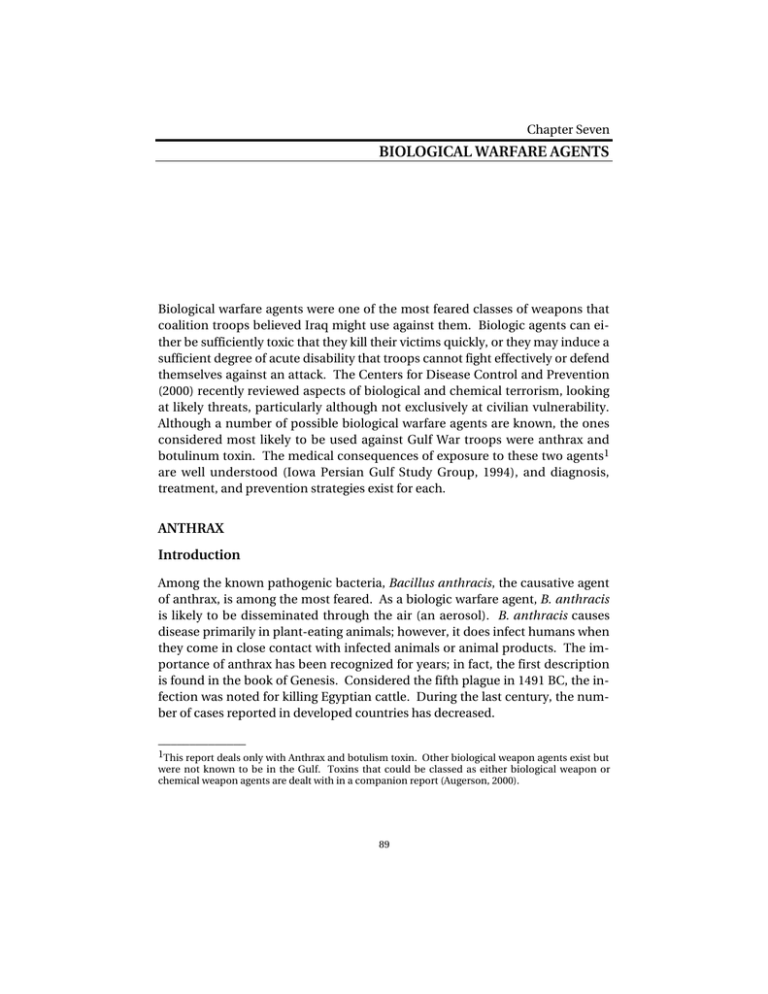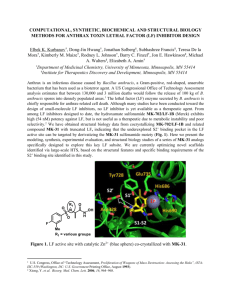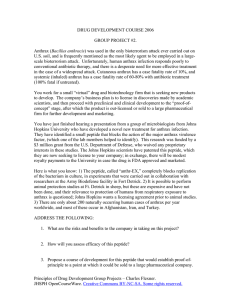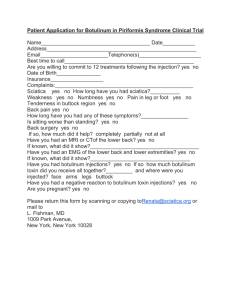BIOLOGICAL WARFARE AGENTS
advertisement

Chapter Seven BIOLOGICAL WARFARE AGENTS Biological warfare agents were one of the most feared classes of weapons that coalition troops believed Iraq might use against them. Biologic agents can either be sufficiently toxic that they kill their victims quickly, or they may induce a sufficient degree of acute disability that troops cannot fight effectively or defend themselves against an attack. The Centers for Disease Control and Prevention (2000) recently reviewed aspects of biological and chemical terrorism, looking at likely threats, particularly although not exclusively at civilian vulnerability. Although a number of possible biological warfare agents are known, the ones considered most likely to be used against Gulf War troops were anthrax and botulinum toxin. The medical consequences of exposure to these two agents1 are well understood (Iowa Persian Gulf Study Group, 1994), and diagnosis, treatment, and prevention strategies exist for each. ANTHRAX Introduction Among the known pathogenic bacteria, Bacillus anthracis, the causative agent of anthrax, is among the most feared. As a biologic warfare agent, B. anthracis is likely to be disseminated through the air (an aerosol). B. anthracis causes disease primarily in plant-eating animals; however, it does infect humans when they come in close contact with infected animals or animal products. The importance of anthrax has been recognized for years; in fact, the first description is found in the book of Genesis. Considered the fifth plague in 1491 BC, the infection was noted for killing Egyptian cattle. During the last century, the number of cases reported in developed countries has decreased. ______________ 1This report deals only with Anthrax and botulism toxin. Other biological weapon agents exist but were not known to be in the Gulf. Toxins that could be classed as either biological weapon or chemical weapon agents are dealt with in a companion report (Augerson, 2000). 89 90 Infectious Diseases What Infected Patients Experience Naturally acquired disease typically occurs in one of three types—cutaneous anthrax, respiratory anthrax, or gastrointestinal anthrax. In developed countries, most anthrax cases are of the skin or “cutaneous” type (95 percent); approximately 5 percent are of the respiratory type. The cutaneous type ultimately causes ulceration and scarring over a several-week period, although about 20 percent of untreated cases result in death. The respiratory form has a much higher mortality, being usually fatal. This is the type of infection expected with use of B. anthracis as a biological warfare agent. Respiratory anthrax is contracted by breathing in bacterial spores, as would be the case when B. anthracis is used as a biological warfare agent. This type of anthrax has two phases. The first phase occurs with a relatively small exposure (e.g., animal contact) and is sometimes nondescript with patients manifesting symptoms similar to the common cold or flu (e.g., tiredness, muscle aches, mild fever, and a nonproductive cough). Some patients also experience some chest tightness. At this stage, physical examination is not revealing, and diagnosis is difficult. After several days patients improve, again leading the patient and physician to attribute the symptoms to a cold or flu. Shortly thereafter patients experience the sudden onset of respiratory symptoms including shortness of breath and inability to take in oxygen. Patients usually die (from pulmonary hemorrhage) within 24 hours of the onset of this phase of the disease. Prevention Vaccination2 is effective (92.5 percent) in preventing anthrax infection (Lew, 1995), which is why some individuals (approximately 150,000) deployed to the highest-risk areas of the Persian Gulf were vaccinated against anthrax. Although the initial findings in patients infected with anthrax mimic some of the findings in individuals with Gulf War illnesses, anthrax is not known to have a chronic state. Therefore, its use as a biologic warfare agent would have resulted in the devastating findings discussed above in multiple individuals shortly after exposure. BOTULINUM TOXIN Introduction Clostridium botulinum is the pathogenic bacterium that is the causative agent of botulism. However, unlike B. anthracis, it is not the bacterium itself that is ______________ 2For a complete discussion of vaccine, see the companion report in this series (Golomb, forthcoming). Biological Warfare Agents 91 toxic but rather the toxins produced by the bacteria. These toxins affect the nervous system, resulting in weakness. Although tetanus results from toxins produced by another member of the same family of bacteria (Clostridium tetani), tetanus toxin acts on a different part of the nervous system and produces muscle spasm and rigidity (Bleck, 1995). Epidemiologic Information Before modern medicine, the botulism fatality rate was over 60 percent; however, with current medical intervention the overall fatality rate is less than 10 percent. Because botulism carries a high morbidity and mortality, it is considered a biological warfare agent (Wiener, 1996). Depending on the strain, C. botulinum produces different toxins, designated A through G, of which types A, B, E, and F cause human disease (Townes et al., 1996; Inoue et al., 1996; Jean et al., 1995; Singh et al., 1995; Weber et al., 1993). This bacterium is found throughout the world and can survive in harsh conditions. What Infected Patients Experience The toxin may ingested with food or water and absorbed into the blood and then progress via the blood to the nervous system. There is also wound botulism, where the infection begins at an open wound where bacteria grow and produce the toxin. Botulinum toxin can also be delivered by the aerosol route; this method affords broader area spread, greater casualties, and less loss of the agent than introducing it into the food or water supplies. Because toxins are environmentally stable, this is the most probable route to deliver this agent as a biological weapon. The presence of the toxin, however, determines the clinical manifestations, rather than how or where the toxin enters the body. The chemical structure and mechanism of action for each of the seven toxins is similar. The toxin cleaves at least one of three proteins that are involved in bringing the neurotransmitter acetylcholine to the nerve synapse (the location where the nerve to nerve transmission of information occurs). Cleavage by the neurotoxin inhibits acetylcholine release from the synapse (Schiavo and Montecucco, 1997). With the loss of communication between nerves, paralysis results. The dominant clinical features of botulism are the neurologic symptoms secondary to toxin-mediated blockade of the voluntary motor and autonomic cholinergic junctions (Centers for Disease Control and Prevention, 1998). With mild botulism, patients may experience only dry mouth, inability to focus (perceived as blurred vision), and diplopia. With more severe disease, dysphonia, dysarthria, dysphagia, and peripheral muscle weakness may ensue. When the respiratory system fails, mechanical ventilator support becomes necessary, 92 Infectious Diseases often for many weeks. The recovery period reflects the time for the body to regenerate damaged nerve fibers. Like anthrax, chronic states of botulism are not known. If there had been a significant exposure to botulinum toxin during the Gulf War, the severe, disabling, and life-threatening findings discussed above would have been seen at that time. Although a low-level exposure has been hypothesized, this does not appear to be the case for these agents. Recently, this toxin has been used in low doses to successfully treat patients who have conditions associated with increased muscular activity (e.g., twitching and spasm) (Joo et al., 1996; Rebolleda and Munoz Negrete, 1996; Richman, 1997; Sampaio et al., 1997; Esper et al., 1997; Sood et al., 1996; Behari and Raju, 1996). To date, symptoms similar to Gulf War illnesses have not been reported in patients receiving therapeutic doses of botulinum toxin. SUMMARY Both anthrax and botulinum toxin result in recognizable, characteristic symptoms that can be confirmed by available diagnostic techniques. No cases were diagnosed, and it is therefore highly unlikely that any exposure occurred.





